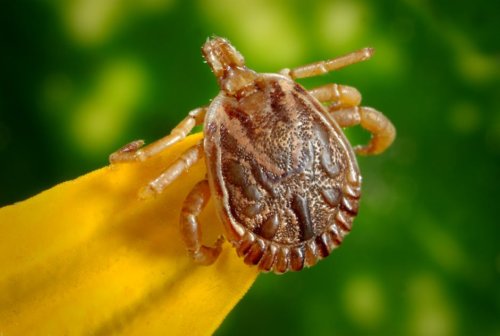
While ticks are hardy creatures that can withstand a variety of temperatures, they thrive during the summer months. Combine that with more frequent frolicking outdoors, and issues like tick bites and bacterial infections like Lyme disease are a real risk. According to the Johns Hopkins Lyme Center, over 300,000 new cases of Lyme are estimated each year in the U.S. Here are some tips to keep this summer tick free!
What are ticks and why are they a big deal?
Ticks are outdoor parasitic pests that are related to spiders. They range from 1/10th of an inch long to just over a 1/2 inch, and they come in different types, such as deer, lone star, dog, etc. If they attach to your skin, they will feed on your blood. The problem is that while the ticks feed, bacteria can transfer to your bloodstream. In addition to Lyme, there are a number of co-infections that can occur, or even random effects, like becoming allergic to meat from a lone star tick bite.
Deer ticks can transmit Lyme if they carry the bacteria and have been attached and feeding on you for over 36 hours. Because ticks are so small, they can sometimes go unnoticed on a person, especially as they like to hide in warm, dark areas that we don’t really look at frequently like arm and knee pits, belly buttons, ears or hairlines.
Lyme disease, if not treated right away, can lead to skin rashes, facial paralysis, painful and/or swollen joints, headaches, nerve pain and tingling in extremities.
Where and when can you find ticks?
The Center for Disease Control has maps of the United States that show where ticks are found, with concentrations in the Northeast, parts of the South and Midwest, and growing cases in California.
Ticks tend to be in areas like forests or spaces with high grass, shrubs, and bushes. Paths through the woods meant for hiking, sea grass on the dunes and even your own backyard can be a breeding ground for ticks. Although the ones that spread the Lyme-causing bacteria are called deer ticks, areas with large mouse populations can be at risk. The rodents are highly efficient transmitters of the bacteria and are more widespread than deer, making even urban areas susceptible to ticks.
While they can live in most climates all year round (though they do not do well in freezing temperatures), you’ll find more of them around in spring, summer, and fall, with the warmest months being the most common for tick bites.

How can you prevent tick exposure?
- Wear light-colored long sleeves and long pants when hiking in grassy, brushy or wooded areas. This will help prevent ticks from getting to your skin and the light color will help small ticks stand out better for removal. Tucking your pants into your socks may not be the coolest fashion statement, but it is one extra way to use your clothes to your benefit.
- The CDC recommends using EPA-registered insect repellents that contain DEET, Oil or Lemon Eucalyptus, para-menthane-diol, or 2-undecanone when going out into areas that may contain ticks.
- When outdoors, do your best to avoid areas that ticks love. If you hike, stick to the trail and avoid overgrown or uncleared areas.
- Check your clothes for ticks as soon as you get indoors. If you find any on your clothes remove immediately. Body checks after lengthy outdoor time is a must! Conduct a full scan of your body after being outside in potentially-tick infested areas. Use a mirror (or a very close friend/family member) to help check those hard-to-see spots that ticks seem to love. Don’t forget to check your four-legged friends as well, as pets can bring ticks into the house that can then transfer to you.
- Take a shower. Studies have shown that showering within two hours of possible tick exposure can help reduce the risk of getting Lyme or other tick-borne diseases.
What if you find a tick?
If you do find a tick on yourself or a family member, remain calm. It takes 36 hours of contact for the bacteria that causes Lyme to enter the bloodstream, so even if you happen to find a tick on you, most likely, you are fine (especially if you are vigilant with tick checks).
The most important thing to do is to remove the tick whole. You do not want to leave any piece of it in or on you and risk infection. Using pointed tweezers, grab the tick from its mouthpart (if you’re able to see it) then slowly and gently pull it back until it is out of the skin. Try not to squish or crush the tick as you remove it. Clean the area with soap and water afterward.
Concerned about Lyme or other tick-borne infections?
It’s understandable to be concerned when it comes to Lyme. It is something I am incredibly vigilant about, given that my son has had two different cases of Lyme disease, over a year apart. The first time we had found the tick, and he presented with the telltale rash only days later. He was able to start his course of antibiotics (which can last from a week to over a month depending on how long you’ve been infected with the bacteria). The second time, he did not have the rash, but rather other symptoms such as swollen/painful joints, warm/tender skin, and intense mood swings and other mental health issues caused by the Lyme impacting his nervous system. It took a little more time to bounce back from the second infection but we did, and he has no lasting effects.
While the idea of Lyme can be scary, keep in mind that only 2 percent of all tick bites result in the disease. A doctor’s diagnosis and a blood test will usually confirm if you have Lyme.
If you find a tick and are unsure how long it has been on, do the following:
- Remove the tick immediately and place it in a plastic baggie.
- Using a permanent marker, drawn a small circle around the tick bite.
- Keep an eye on the area to see if a red, circular rash appears within the next week or so, or if it feels warm and tender to the touch. If it does, make an appointment immediately. A course of antibiotics will be enough to take care of the Lyme before more severe symptoms occur.
- In some cases, the circular rash doesn’t show, or there is a rash elsewhere on the body. If you experience any of the following symptoms, schedule an appointment with your doctor ASAP: pain in your joints, flu-like symptoms, unexplained fever or fatigue.
- You can also test the tick you remove for Lyme by sending it to a number of research facilities in the country. Many commercial testing sites exist, but may not be following any specific protocol. I suggest seeing if any Universities near you have a testing facility, such as this one at UMASS, which I’ve personally used twice before.


Grok Nation Comment Policy
We welcome thoughtful, grokky comments—keep your negativity and spam to yourself. Please read our Comment Policy before commenting.